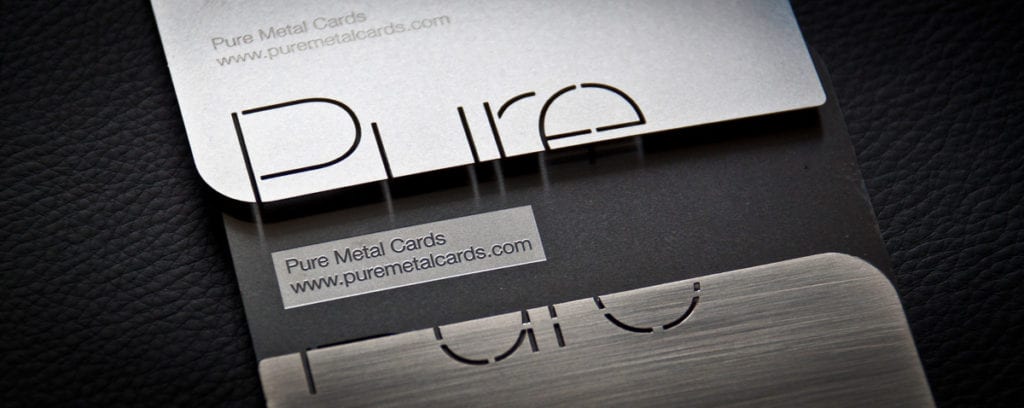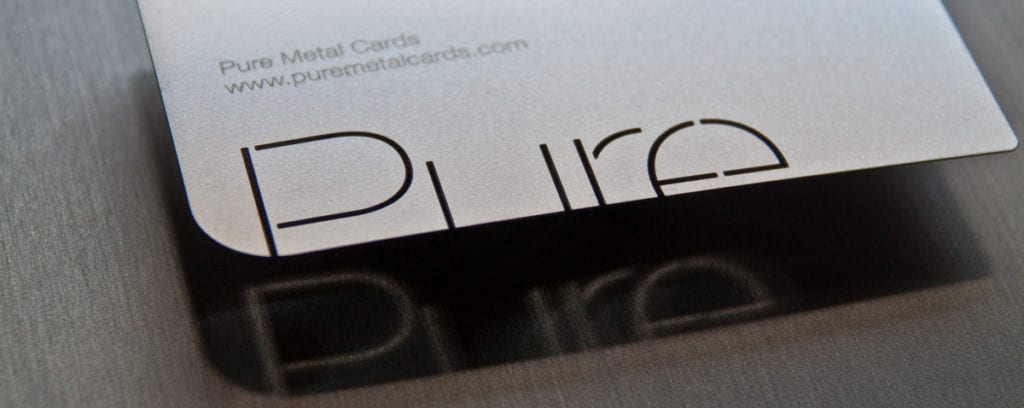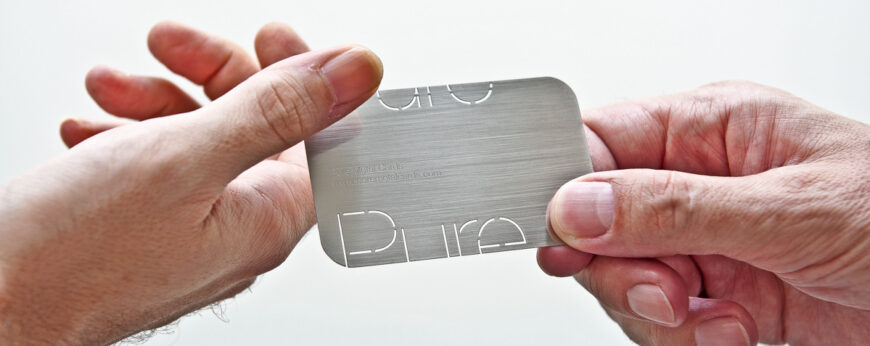The perfect business card should create a wow impact as much as being a source of information. However, most business cards are instantly ignored. Handing out business cards should be a conversation starter, something to interest the receiver and be acted on. Creating the perfect business card is simply a matter of finding the right balance between the two. With the help of Pure Metal Cards, we can create a metal business card that will make you unforgettable!
The best business cards are those that spark a conversation once they’re received. The card needs to be designed to tell the recipient something about you, your company or your brand without even reading the fine print. The card should reflect the style or approach of your business through its presentation. Today, simplicity is powerful. A good business card is one the recipient cannot stop looking at, put down or want to toss away. If you look at your existing business card, does it convey who you are and what your brand stands for? Is all the information useful or relevant to the recipient? The perfect business card serves one purpose – to provide information about you and your work, and they hopefully encourage the receiver to follow up with you in some way. And as part of your identity, a great business card reflects your personality.
 Does Size Matter?
Does Size Matter?
Business cards can be made in any size or shape. Our metal business cards and membership cards can also be made into any size. The standard card sizes are:
3.3” x 2.2” (85.6mm x 54.0mm) – credit card size
3.5” x 2.0” (89.0mm × 51.0mm) - USA and Canada size
For details on the standard size for your country please check business card sizing.
We can create a card in any shape or size. Do consider though, how the receiver of your card will be able to store or carry the card if the card is not a standard size. Use a different size corner radius to stand out. We don’t make metal cards with square corners, as they will be sharp and potentially harmful.
Our metal business cards are available in a range of card thicknesses from 0.3mm to 0.8mm (credit) card thicknesses. We can also create thicker cards if required. Thicker cards are naturally heavier, something to consider when you’re carrying many for an event or a function! For business cards, we recommend 0.3mm card thickness and 0.6mm or 0.8mm for member cards or VIP cards.
Change the Orientation
Changing the orientation from horizontal to vertical can make your card stand out as well, and adding patterning around the edges can make a simple design more complex.
Logo
The front side of your card should include your logo and your name. Be bold, beautiful and unique. To make that ‘wow’ effect be either visually stimulating or having interesting and engaging content.
If you are starting out or a start-up you should consider hiring a graphic designer to assist you to create your brand image and presence. A good starting point is Upwork, Freelancer or Fiverr.
Your logo design can be physically raised (embossed) or recessed (debossed) into the business card. Be careful when embossing text though, if the words are too small or if you don’t use ink to accentuate them, they won’t be readable. On metal business cards we typical etch the details then add color or laser etched into the metal surface.
Play with Type
Typography can be used for both information and decoration in the place of graphics. Only use one font or two at most to keep the design looking contemporary and stylish. The main focus in designing the perfect business card is to always keep the readability of the text.
Card Content
The main reason you give someone your business card is so they will have your contact information, but how much information do they actually need? The majority of business cards are cluttered with the excessive ways to connect. For example, office, direct and cell/mobile phone numbers, a fax number (when did you last send a fax?), street address, email, URL, and a plethora of social media icons. It’s time to strip most of that away, relying on your website to provide the main connection options. If you don’t need card recipients to visit you, why include your address? Simplify further with one phone number, one email address and a URL that takes you to each employee’s personal profile or page on your company website or social media profile. The effect is understated yet bold.
A physical address on a card should only be for someone who only works offline. If your company or brand has a strong web presence, you should skip the address to save space. Only include it when you rely on in-store or at premises visitors.
If you do want to drive visits, an address is essential. Instead of worrying about how much space it’s occupying, why not go all out and put a map on the back of the card? This is simple enough to do with Google Maps, so long as you include a copyright attribution. You could also use a QR code to link to the map too.
You may also want to link to a blog, video, or ‘about page’ that introduces card recipients to you. Just make sure the URL isn’t too complicated. You can use a custom shortened URL like Bit.ly to make the address easier to read and remember.
QR codes occupy a lot of space, but they’re still the most efficient way to link printed and online materials together. They’re visually cleaner than URLs, making them the perfect combination of professional and casual. You can link them to your website, or you can use them in other creative ways. QR codes can be easily created at sites like QR Code generator or QR stuff.
Phone numbers are extremely important. Believe it or not, some people still prefer talking on the phone because it’s more personal than a website and less likely to be misinterpreted than an email. If you’re dealing with multiple numbers, be sure to label or use icons to identify which number is which, for example, office or cell number. You’ll also probably want to avoid including any personal, non-business numbers.
Most people pair email and web addresses together. That way, prospects can either contact you directly or explore your website on their own.
It’s a good rule of thumb to only promote the social media presence that’s most relevant to your brand. Choosing which social profile to include is a complicated process, so be sure to reflect the nature of your business. Instagram probably isn’t the best choice for professional services, for example. You might consider just showing three or four icons too, as these reflect your media presence rather than an ability to physically visit each site.
Tag Lines
Contact information is the main part of a business card’s message, but a card that only informs people how to contact you isn’t very compelling. You also need to tell the recipient why they should contact you. That usually means a tagline or a call to action.
A call to action, on the other hand, is a command. It gives prospects a clear next step, like “call and get a free quote!” or “visit our website!” Your call to action might even be in the form of a promotional offer, allowing customers to take the card to your store or premises and redeem it for discounts or free samples. Only include one call to action, though; consumers respond best when they’re given just one thing to do.
Add photos or Illustrations
Adding photos to a business card lets you express certain things that words can’t. For instance, you might use a photographic background to showcase examples of your client’s work or a portrait to remind prospects who the cardholder is. Pure Metal Cards can print full color images or include your photograph to ensure impact with your business card design.
Portraits are especially effective because they let people match your name to the person they met earlier, making it an easy way to refresh their memory when they come across the card later. Just make sure your photo is appropriate and business like.
Card Color
Adding a splash of color can enhance your card and make it more noticeable. When requesting colors you should use one of two industry standards for color matching. PMS stands for the Pantone Matching System, which is based on over a thousand standardized ink colors. PMS inks are pre-mixed to match those color values, making this an excellent choice when you need to match an existing logo or color scheme as closely as possible.
Four-color (4C) process is also known as CMYK because each ink color is formed from a combination of cyan, magenta, yellow, and black (also known as “key”). That gives you access to a full spectrum of color instead of just specific hues. If you want your business card to incorporate full-color photography or a design that contains four or more colors, this is your best option.
Be aware that the color may look slightly duller on a metal card compared to paper or plastic. On metal cards, we are unable to offer specialty inks (like neon and metallic colors).
 Metal Card Considerations
Metal Card Considerations
One issue that is more noticeable on metal cards is fingerprints, especially on our mirror finishes on stainless steel, brass and copper. We do offer brushed, frosted, prism and contour card finishes which are better at masking fingerprints.
Cutting through (die cut) the metal is another way to make your card truly distinctive. We can help with changing your existing design to work on metal. We can deboss lettering into the card but cannot emboss to make raised characters or numbers.
We etch the design and details to each card and then add silk screen printing if a color is required. We can also laser etch your details to give a more distinctive finish. We can add full color but we generally recommend using only one or two colors and letting the metal finish stand out. We do require the Pantone color code for your colors. For an extra special card, we can also gold-plate or silver-plate your card.
Speak to Who You Are
Use imagery and colors that match your brand of business. For example, use green for fresh products or black and white for film production.
Your perfect business card is a reflection of you, think of some interesting things about yourself and incorporate that into your card. Don’t over saturate a business card with anything other than the necessary information. If it doesn’t add, take it away. Spend time, make it effective, and remember, this is the first piece of work that will represent your company on most occasions, so make this design matter. We have created a helpful artwork guidelines document that provides all the information you might need to create your card. Handing out a Pure Metal Card you will be the talk of the town! More articles and information about metal business cards are available on our blog.

